Inhibitory Effect of Rosa rugosa Tea Extract on the Formation of Heterocyclic Amines in Meat Patties at Different Temperatures
Abstract
:1. Introduction
2. Results and Discussion
2.1. Total Phenolic Compounds (TPC),Total Antioxidant Capacity and Radical Scavenging Activity
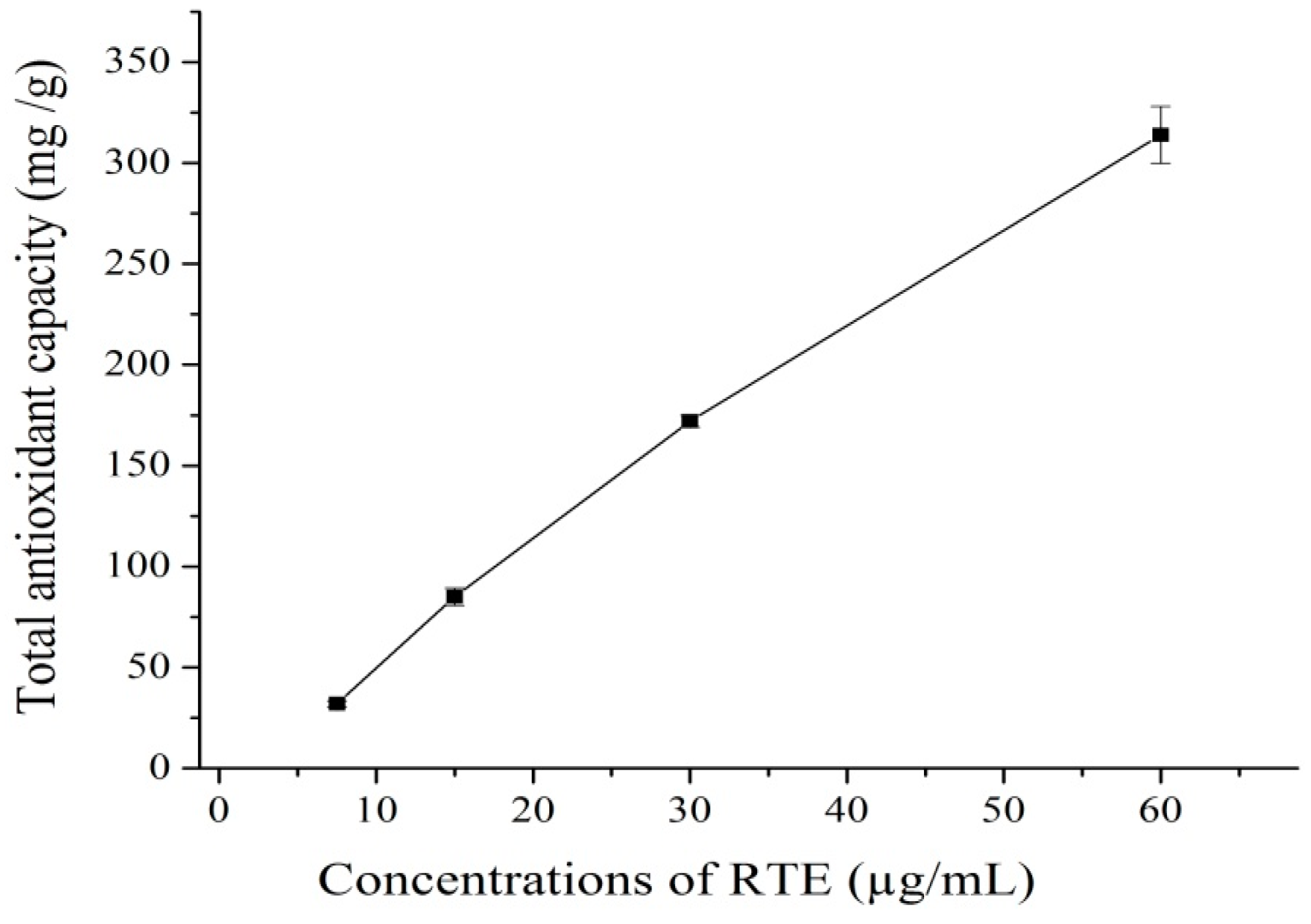

2.2. Cooking loss, pH and Color
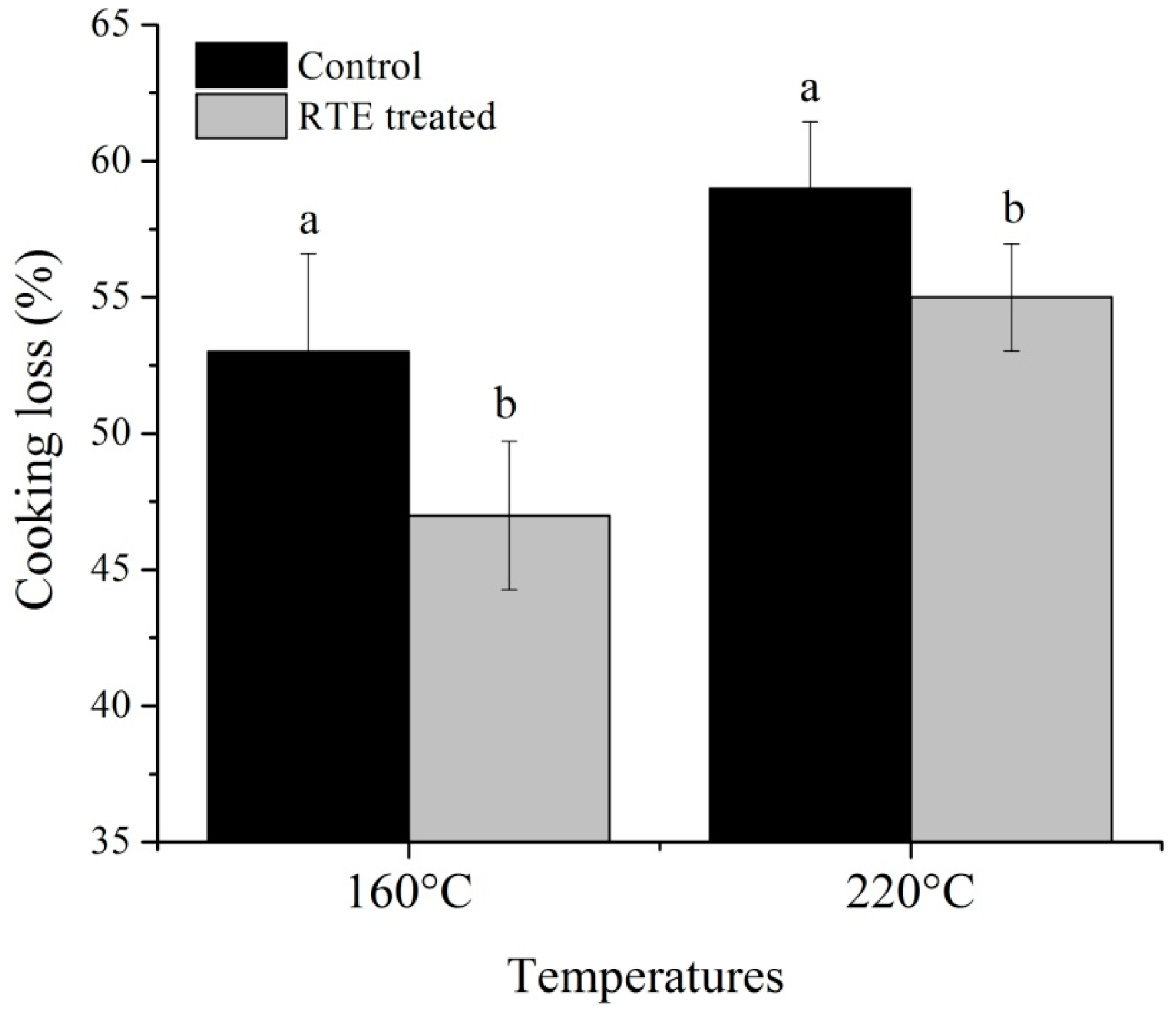
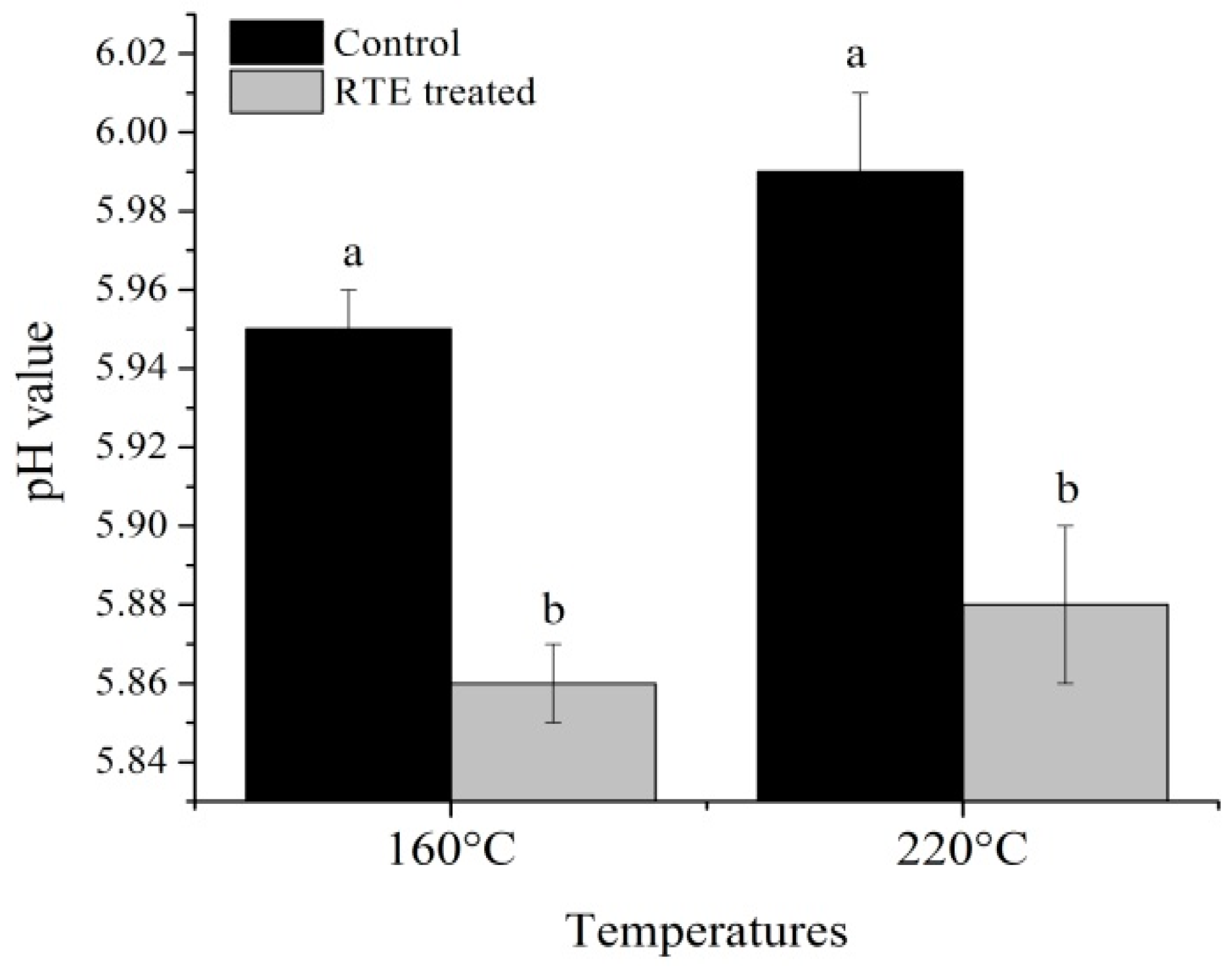
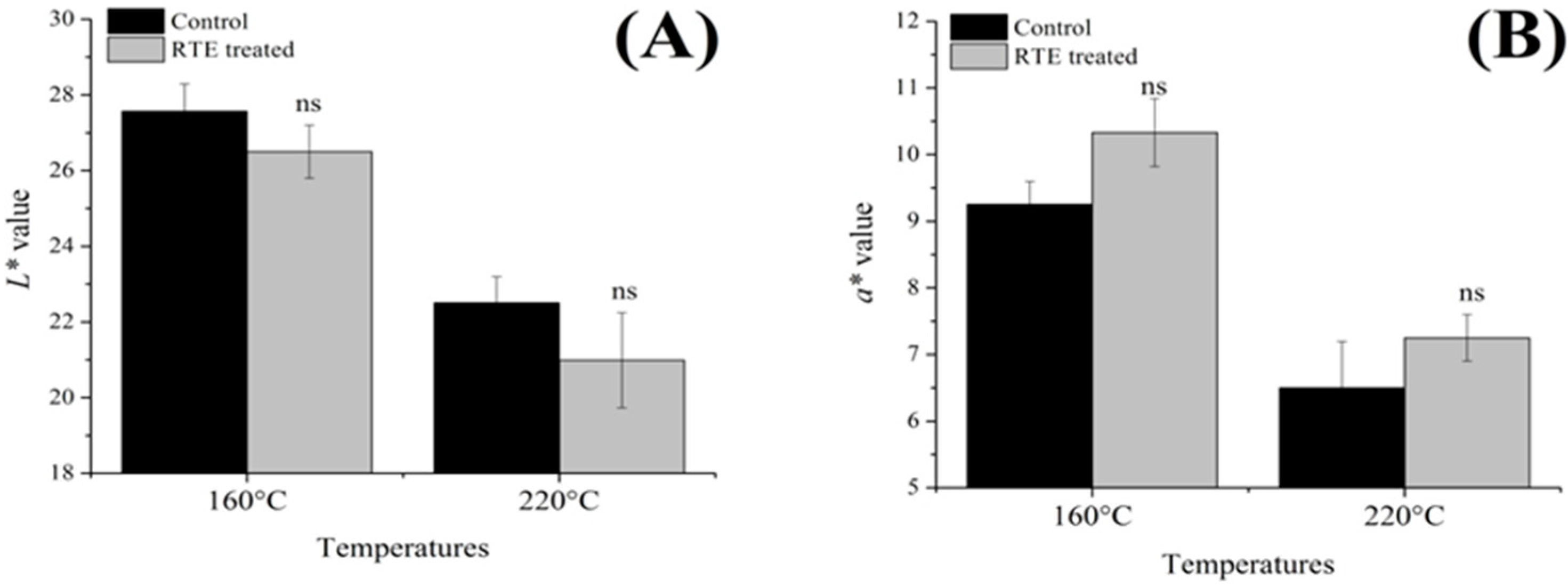
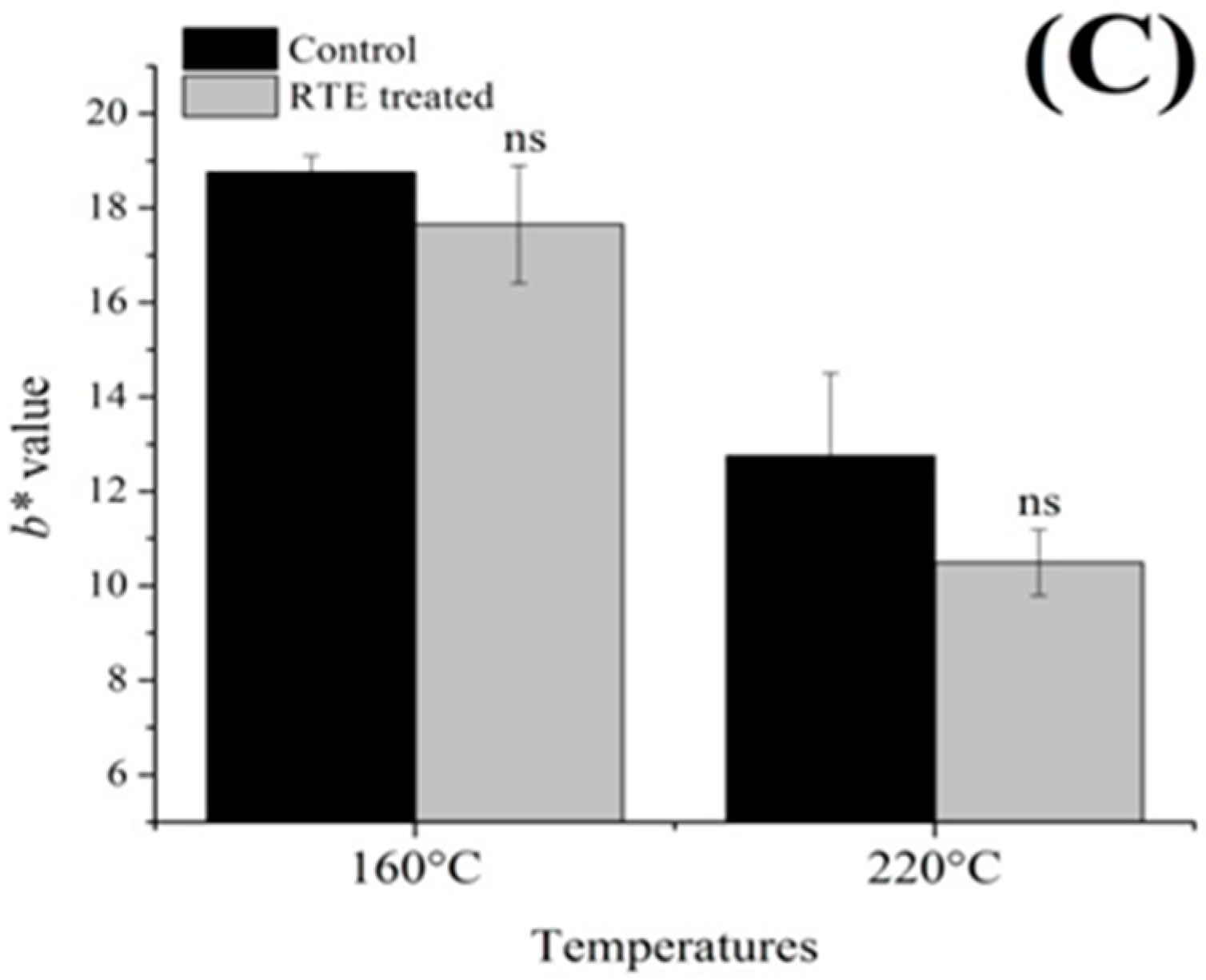
2.3. HCA Contents
| Temperatures | Norharman | Harman | Trp-P-2 | PhIP | Trp-P-1 | AαC | MeAαC | 7,8-DiMeIQx | Other HCAs | |
|---|---|---|---|---|---|---|---|---|---|---|
| 160 °C | Control | 0.53 ± 0.28 | 0.40 ± 0.14 | nd | 1.85 ± 0.98 | nd | 0.59 ± 0.21 | 1.10 ± 0.91 | nd | nd |
| RTE | 0.48 ± 0.28 | 0.46 ± 0.02 | nd | 0.18 ± 0.04 | nd | nd | nd | nd | nd | |
| Significance | ns | ns | * | - | - | |||||
| 220 °C | Control | 5.75 ± 0.46 | 5.54 ± 0.51 | 1.09 ± 0.42 | 28.05 ± 3.32 | 3.35 ± 0.63 | 0.73 ± 0.13 | 0.60 ± 0.14 | 0.52 ± 0.01 | nd |
| RTE | 3.42 ± 0.59 | 3.79 ± 0.02 | 0.27 ± 0.05 | 14.0 ± 3.10 | 1.84 ± 0.47 | 0.64 ± 0.05 | 0.66 ± 0.40 | nd | nd | |
| Significance | * | * | ** | *** | ** | ns | ns | - | ||
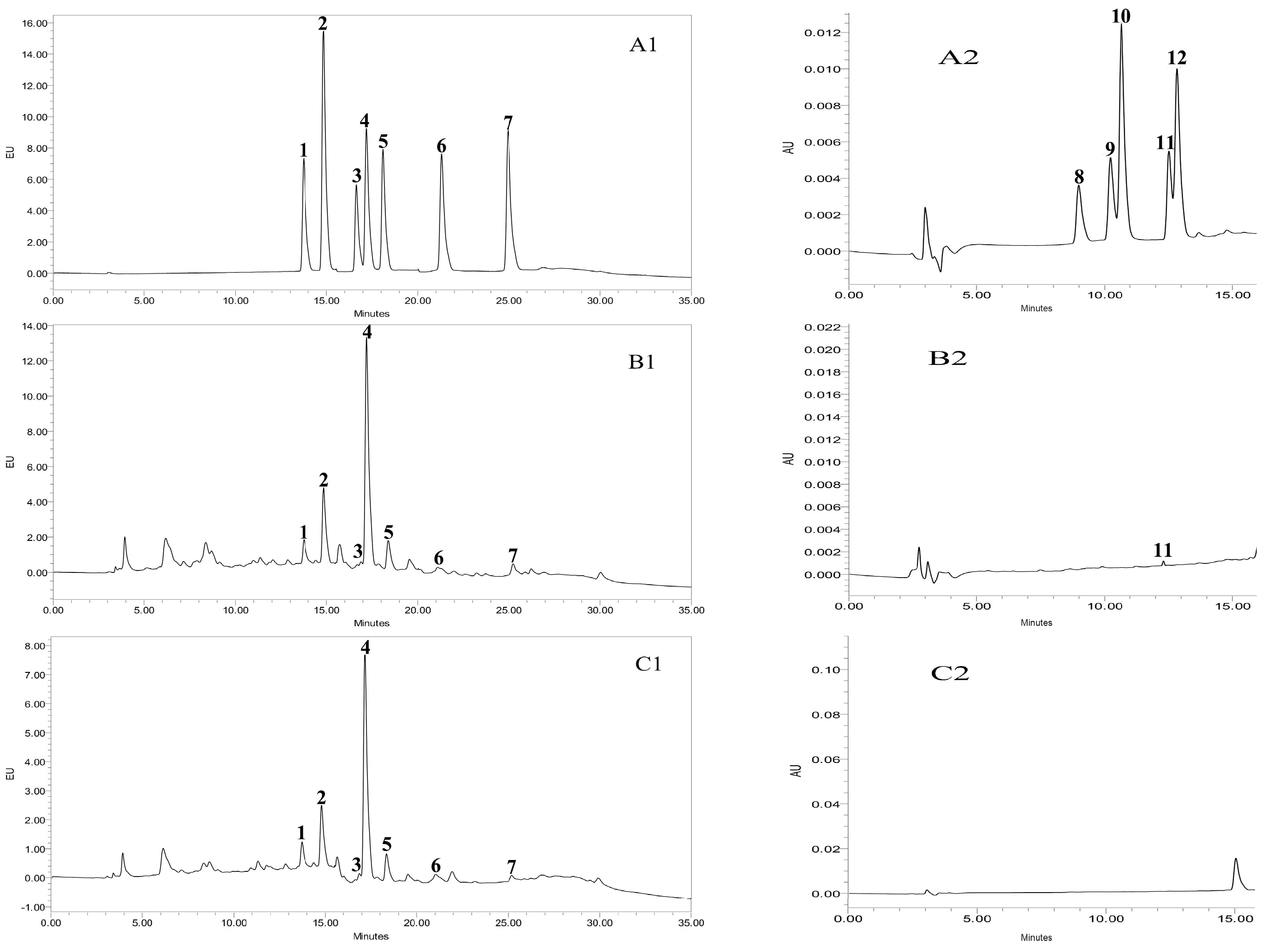
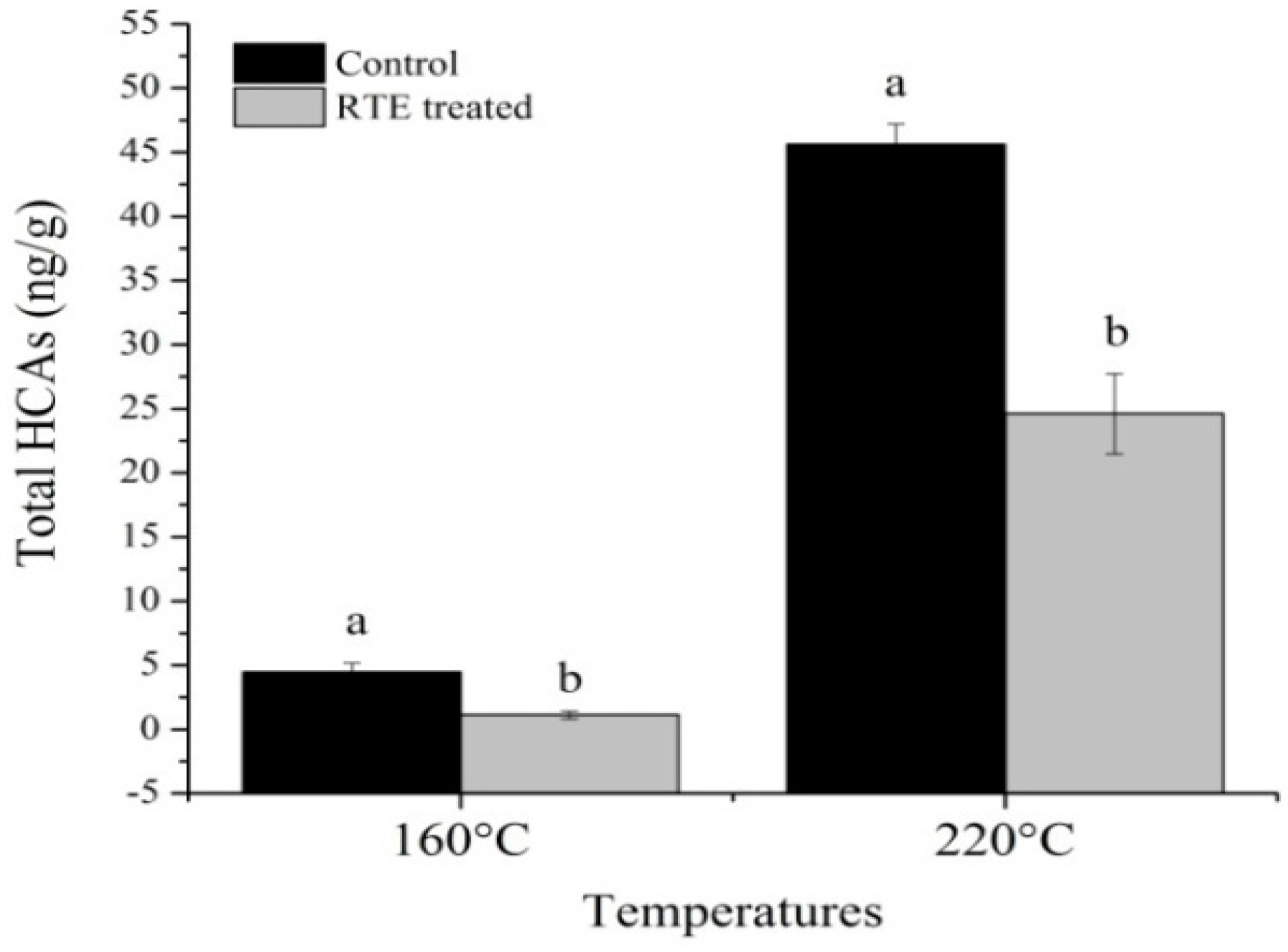
3. Experimental Section
3.1. Chemicals
3.2. Instrumentation
3.3. Rosa rugosa Tea and Preparation of the Extract
3.4. Determination of the Total Phenolic Compounds, Total Antioxidant Capacity and Radical Scavenging Activity of Rosa Rugosa Tea Extract (RTE)
3.5. Preparation and Frying of Beef Patties
3.6. Determination of Cooking Loss, pH and Color
3.7. Extraction, Purification and Quantification of HCAs
3.8. Statistical Analysis
4. Conclusions
Acknowledgments
Author Contributions
Conflicts of Interest
References
- de Castro Cardoso Pereira, P.M.; dos Reis Baltazar Vicente, A.F. Meat nutritional composition and nutritive role in the human diet. Meat Sci. 2013, 93, 586–592. [Google Scholar] [CrossRef] [PubMed]
- Cooper, K.M.; Jankhaikhot, N.; Cuskelly, G. Optimised extraction of heterocyclic aromatic amines from blood using hollow fibre membrane liquid-phase microextraction and triple quadrupole mass spectrometry. J. Chromatogr. A 2014, 1358, 20–28. [Google Scholar] [CrossRef] [PubMed] [Green Version]
- Khan, M.R.; Busquets, R.; Saurina, J.; Hernández, S.; Puignou, L. Identification of seafood as an important dietary source of heterocyclic amines by chemometry and chromatography–mass spectrometry. Chem. Res. Toxicol. 2013, 26, 1014–1022. [Google Scholar] [CrossRef] [PubMed]
- Alaejos, M.S.; Ayala, J.; González, V.; Afonso, A. Analytical methods applied to the determination of heterocyclic aromatic amines in foods. J. Chromatogr. B 2008, 862, 15–42. [Google Scholar] [CrossRef] [PubMed]
- Turesky, R.J.; le Marchand, L. Metabolism and biomarkers of heterocyclic aromatic amines in molecular epidemiology studies: Lessons learned from aromatic amines. Chem. Res. Toxicol. 2011, 24, 1169–1214. [Google Scholar] [CrossRef] [PubMed]
- Warzecha, L.; Janoszka, B.; Błaszczyk, U.; Stróżyk, M.; Bodzek, D.; Dobosz, C. Determination of heterocyclic aromatic amines (HAs) content in samples of household-prepared meat dishes. J. Chromatogr. B 2004, 802, 95–106. [Google Scholar] [CrossRef] [PubMed]
- Arvidsson, P.; Boekel, M.; Skog, K.; Jägerstad, M. Kinetics of formation of polar heterocyclic amines in a meat model system. J. Food Sci. 1997, 62, 911–916. [Google Scholar] [CrossRef]
- Ruan, E.; Juárez, M.; Thacker, R.; Yang, X.; Dugan, M.; Aalhus, J. Dietary vitamin E effects on the formation of heterocyclic amines in grilled lean beef. Meat Sci. 2014, 96, 849–853. [Google Scholar] [CrossRef] [PubMed]
- Matsumoto, T.; Yoshida, D.; Tomita, H. Determination of mutagens, amino-α-carbolines in grilled foods and cigarette smoke condensate. Cancer Lett. 1981, 12, 105–110. [Google Scholar] [CrossRef]
- Busquets, R.; Bordas, M.; Toribio, F.; Puignou, L.; Galceran, M.T. Occurrence of heterocyclic amines in several home-cooked meat dishes of the Spanish diet. J. Chromatogr. B 2004, 802, 79–86. [Google Scholar] [CrossRef] [PubMed]
- Jägerstad, M.; Skog, K.; Arvidsson, P.; Solyakov, A. Chemistry, formation and occurrence of genotoxic heterocyclic amines identified in model systems and cooked foods. Z. Lebensm. Unters. Forsch. 1998, 207, 419–427. [Google Scholar]
- Nagao, M.; Honda, M.; Seino, Y.; Yahagi, T.; Sugimura, T. Mutagenicities of smoke condensates and the charred surface of fish and meat. Cancer Lett. 1977, 2, 221–226. [Google Scholar] [CrossRef]
- IARC, Working Group on the Evaluation of Carcinogenic Risks to Humans International Agency for Research on Cancer. Some Naturally Occurring Substances: Food Items and Constituents, Heterocyclic Aromatic Amines and Mycotoxins. 1993. Available online: http://bases.bireme.br/cgi-bin/wxislind.exe/iah/online/?IsisScript=iah/iah.xis&src=google&base=WHOLIS&lang=p&nextAction=lnk&exprSearch=9283212568&indexSearch=ID (accessed on 28 January 2016).
- Youwei, Z.; Jinlian, Z.; Yonghong, P. A comparative study on the free radical scavenging activities of some fresh flowers in southern China. LWT-Food Sci. Technol. 2008, 41, 1586–1591. [Google Scholar] [CrossRef]
- Altıner, D.; Kılıçgün, H. The antioxidant effect of Rosa rugosa. Drug Metabol Drug Interact. 2008, 23, 323–328. [Google Scholar] [CrossRef] [PubMed]
- Zhang, J.; Rui, X.; Wang, L.; Guan, Y.; Sun, X.; Dong, M. Polyphenolic extract from Rosa rugosa tea inhibits bacterial quorum sensing and biofilm formation. Food Control. 2014, 42, 125–131. [Google Scholar] [CrossRef]
- Vinokur, Y.; Rodov, V.; Reznick, N.; Goldman, G.; Horev, B.; Umiel, N.; Friedman, H. Rose Petal Tea as an Antioxidant-rich Beverage: Cultivar Effects. J. Food Sci. 2006, 71, S42–S47. [Google Scholar] [CrossRef]
- Banerjee, R.; Verma, A.K.; Das, A.K.; Rajkumar, V.; Shewalkar, A.; Narkhede, H. Antioxidant effects of broccoli powder extract in goat meat nuggets. Meat Sci. 2012, 91, 179–184. [Google Scholar] [CrossRef] [PubMed]
- Kumaran, A.; Karunakaran, R.J. In vitro antioxidant activities of methanol extracts of five Phyllanthus species from India. LWT-Food Sci. Technol. 2007, 40, 344–352. [Google Scholar] [CrossRef]
- Negi, P.; Jayaprakasha, G.; Jena, B. Antioxidant and antimutagenic activities of pomegranate peel extracts. Food Chem. 2003, 80, 393–397. [Google Scholar] [CrossRef]
- Li, J.; Hui, T.; Wang, F.; Li, S.; Cui, B.; Cui, Y.; Peng, Z. Chinese red pepper (Zanthoxylum bungeanum Maxim.) leaf extract as natural antioxidants in salted silver carp (Hypophthalmichthys molitrix) in dorsal and ventral muscles during processing. Food Control 2015, 56, 9–17. [Google Scholar] [CrossRef]
- Abdel-Hameed, E.-S.S. Total phenolic contents and free radical scavenging activity of certain Egyptian Ficus species leaf samples. Food Chem. 2009, 114, 1271–1277. [Google Scholar] [CrossRef]
- Yang, L.-C.; Li, R.; Tan, J.; Jiang, Z.-T. Polyphenolics composition of the leaves of Zanthoxylum bungeanum Maxim. grown in Hebei, China, and their radical scavenging activities. J. Agric. Food Chem. 2013, 61, 1772–1778. [Google Scholar] [CrossRef] [PubMed]
- Oz, F.; Kizil, M.; Cakmak, I.; Aksu, M. The Effect of Direct Addition of Conjugated Linoleic Acid on the Formation of Heterocyclic Aromatic Amines in Beef Chops. J. Food Process. Preserv. 2015, 39, 2820–2833. [Google Scholar] [CrossRef]
- Del Pulgara, J.S.; Gázquez, A.; Ruiz-Carrascal, J. Physico-chemical, textural and structural characteristics of sous-vide cooked pork cheeks as affected by vacuum, cooking temperature, and cooking time. Meat Sci. 2012, 90, 828–835. [Google Scholar] [CrossRef] [PubMed]
- Gerber, N.; Scheeder, M.; Wenk, C. The influence of cooking and fat trimming on the actual nutrient intake from meat. Meat Sci. 2009, 81, 148–154. [Google Scholar] [CrossRef] [PubMed]
- Keşkekoğlu, H.; Üren, A. Inhibitory effects of pomegranate seed extract on the formation of heterocyclic aromatic amines in beef and chicken meatballs after cooking by four different methods. Meat Sci. 2014, 96, 1446–1451. [Google Scholar] [CrossRef] [PubMed]
- Lara, M.; Gutierrez, J.; Timon, M.; Andrés, A. Evaluation of two natural extracts (Rosmarinus officinalis L. and Melissa officinalis L.) as antioxidants in cooked pork patties packed in MAP. Meat Sci. 2011, 88, 481–488. [Google Scholar] [CrossRef] [PubMed]
- Jia, N.; Kong, B.; Liu, Q.; Diao, X.; Xia, X. Antioxidant activity of black currant (Ribes nigrum L.) extract and its inhibitory effect on lipid and protein oxidation of pork patties during chilled storage. Meat Sci. 2012, 91, 533–539. [Google Scholar] [CrossRef] [PubMed]
- Gibis, M.; Kruwinnus, M.; Weiss, J. Impact of different pan-frying conditions on the formation of heterocyclic aromatic amines and sensory quality in fried bacon. Food Chem. 2015, 168, 383–389. [Google Scholar] [CrossRef] [PubMed]
- Balogh, Z.; Gray, J.; Gomaa, E.; Booren, A. Formation and inhibition of heterocyclic aromatic amines in fried ground beef patties. Food Chem. Toxicol. 2000, 38, 395–401. [Google Scholar] [CrossRef]
- Jeong, S.-M.; Kim, S.-Y.; Kim, D.-R.; Jo, S.-C.; Nam, K.; Ahn, D.; Lee, S.-C. Effect of heat treatment on the antioxidant activity of extracts from citrus peels. J. Agric. Food Chem. 2004, 52, 3389–3393. [Google Scholar] [CrossRef] [PubMed]
- Xu, G.; Ye, X.; Chen, J.; Liu, D. Effect of heat treatment on the phenolic compounds and antioxidant capacity of citrus peel extract. J. Agric. Food Chem. 2007, 55, 330–335. [Google Scholar] [CrossRef] [PubMed]
- Dong, A.; Lee, J.; Shin, H.-S. Influence of natural food ingredients on the formation of heterocyclic amines in fried beef patties and chicken breasts. Food Sci. Biotechnol. 2011, 20, 359–365. [Google Scholar] [CrossRef]
- Oguri, A.; Suda, M.; Totsuka, Y.; Sugimura, T.; Wakabayashi, K. Inhibitory effects of antioxidants on formation of heterocyclic amines. Mutat. Res. Fundam. Mol. Mech. 1998, 402, 237–245. [Google Scholar] [CrossRef]
- Weisburger, J.H.; Veliath, E.; Larios, E.; Pittman, B.; Zang, E.; Hara, Y. Tea polyphenols inhibit the formation of mutagens during the cooking of meat. Mutat. Res. Genet. Toxicol. Environ. 2002, 516, 19–22. [Google Scholar] [CrossRef]
- Bermudo, E.; Ruiz-Calero, V.; Puignou, L.; Galceran, M. Analysis of heterocyclic amines in chicken by liquid chromatography with electrochemical detection. Anal. Chim. Acta 2005, 536, 83–90. [Google Scholar] [CrossRef]
- Dundar, A.; Sarıçoban, C.; Yılmaz, M.T. Response surface optimization of effects of some processing variables on carcinogenic/mutagenic heterocyclic aromatic amine (HAA) content in cooked patties. Meat Sci. 2012, 91, 325–333. [Google Scholar] [CrossRef] [PubMed]
- Yao, Y.; Peng, Z.; Shao, B.; Wan, K.; Wang, F.; Zhang, Y.; Li, J.; Hui, T. Effects of frying and boiling on the formation of heterocyclic amines in braised chicken. Poultry Sci. 2013, 92, 3017–3025. [Google Scholar] [CrossRef] [PubMed]
- Persson, E.; Sjöholm, I.; Skog, K. Effect of high water-holding capacity on the formation of heterocyclic amines in fried beefburgers. J. Agric. Food Chem. 2003, 51, 4472–4477. [Google Scholar] [CrossRef] [PubMed]
- Skog, K.; Solyakov, A.; Jägerstad, M. Effects of heating conditions and additives on the formation of heterocyclic amines with reference to amino-carbolines in a meat juice model system. Food Chem. 2000, 68, 299–308. [Google Scholar] [CrossRef]
- Oz, F.; Kaya, M. The inhibitory effect of black pepper on formation of heterocyclic aromatic amines in high-fat meatball. Food Control. 2011, 22, 596–600. [Google Scholar] [CrossRef]
- Quelhas, I.; Petisca, C.; Viegas, O.; Melo, A.; Pinho, O.; Ferreira, I. Effect of green tea marinades on the formation of heterocyclic aromatic amines and sensory quality of pan-fried beef. Food Chem. 2010, 122, 98–104. [Google Scholar] [CrossRef]
- Vitaglione, P.; Fogliano, V. Use of antioxidants to minimize the human health risk associated to mutagenic/carcinogenic heterocyclic amines in food. J. Chromatogr. B 2004, 802, 189–199. [Google Scholar] [CrossRef] [PubMed]
- Ahn, J.; Grün, I.U. Heterocyclic amines: 2. Inhibitory effects of natural extracts on the formation of polar and nonpolar heterocyclic amines in cooked beef. J. Food Sci. 2005, 70, C263–C268. [Google Scholar] [CrossRef]
- Liao, G.; Xu, X.; Zhou, G. Effects of cooked temperatures and addition of antioxidants on formation of heterocyclic aromatic amines in pork floss. J. Food Process. Preserv. 2009, 33, 159–175. [Google Scholar] [CrossRef]
- Wang, Y.; Hui, T.; Zhang, Y.; Liu, B.; Wang, F.; Li, J.; Cui, B.; Guo, X.; Peng, Z. Effects of frying conditions on the formation of heterocyclic amines and trans fatty acids in grass carp (Ctenopharyngodon idellus). Food Chem. 2015, 167, 251–257. [Google Scholar] [CrossRef] [PubMed]
- Oz, F.; Cakmak, I.H. The effects of conjugated linoleic acid usage in meatball production on the formation of heterocyclic aromatic amines. LWT-Food Sci. Technol. 2015, 65, 1031–1037. [Google Scholar] [CrossRef]
- Oz, F.; Kızıl, M.; Zaman, A.; Turhan, S. The effects of direct addition of low and medium molecular weight chitosan on the formation of heterocyclic aromatic amines in beef chop. LWT-Food Sci. Technol. 2016, 65, 861–867. [Google Scholar] [CrossRef]
- Khan, M.; Bertus, L.; Busquets, R.; Puignou, L. Mutagenic heterocyclic amine content in thermally processed offal products. Food Chem. 2009, 112, 838–843. [Google Scholar] [CrossRef]
- Shin, H.-S.; Park, H.; Park, D. Influence of different oligosaccharides and inulin on heterocyclic aromatic amine formation and overall mutagenicity in fried ground beef patties. J. Agric. Food Chem. 2003, 51, 6726–6730. [Google Scholar] [CrossRef] [PubMed]
- Oz, F.; Zikirov, E. The effects of sous-vide cooking method on the formation of heterocyclic aromatic amines in beef chops. LWT-Food Sci. Technol. 2015, 64, 120–125. [Google Scholar] [CrossRef]
- Knize, M.; Dolbeare, F.; Carroll, K.; Moore, D.; Felton, J. Effect of cooking time and temperature on the heterocyclic amine content of fried beef patties. Food Chem. Toxicol. 1994, 32, 595–603. [Google Scholar] [CrossRef]
- Skog, K.; Steineck, G.; Augustsson, K.; Jägerstad, M. Effect of cooking temperature on the formation of heterocyclic amines in fried meat products and pan residues. Carcinogenesis 1995, 16, 861–867. [Google Scholar] [CrossRef] [PubMed]
- Persson, E.; Graziani, G.; Ferracane, R.; Fogliano, V.; Skog, K. Influence of antioxidants in virgin olive oil on the formation of heterocyclic amines in fried beefburgers. Food Chem. Toxicol. 2003, 41, 1587–1597. [Google Scholar] [CrossRef]
- Knize, M.G.; Felton, J.S. Formation and human risk of carcinogenic heterocyclic amines formed from natural precursors in meat. Nutr. Rev. 2005, 63, 158–165. [Google Scholar] [CrossRef] [PubMed]
- Cai, Y.-Z.; Sun, M.; Xing, J.; Luo, Q.; Corke, H. Structure–radical scavenging activity relationships of phenolic compounds from traditional Chinese medicinal plants. Life Sci. 2006, 78, 2872–2888. [Google Scholar] [CrossRef] [PubMed]
- Persson, E.; Oroszvári, B.K.; Tornberg, E.; Sjöholm, I.; Skog, K. Heterocyclic amine formation during frying of frozen beefburgers. Int. J. Food Sci. Technol. 2008, 43, 62–68. [Google Scholar] [CrossRef]
- Chen, J.H.; Ho, C.-T. Antioxidant activities of caffeic acid and its related hydroxycinnamic acid compounds. J. Agric. Food Chem. 1997, 45, 2374–2378. [Google Scholar] [CrossRef]
- Puangsombat, K.; Smith, J.S. Inhibition of heterocyclic amine formation in beef patties by ethanolic extracts of rosemary. J. Food Sci. 2010, 75, T40–T47. [Google Scholar] [CrossRef] [PubMed]
- Yoshida, D.; Mizusaki, S. Formation of mutagens by heating amino acids with addition of hydroquinone. Agric. Biol. Chem. 1985, 49, 1199–1200. [Google Scholar] [CrossRef]
- Kikugawa, K.; Kato, T.; Hiramoto, K.; Takada, C.; Tanaka, M.; Maeda, Y.; Ishihara, T. Participation of the pyrazine cation radical in the formation of mutagens in the reaction of glucose/glycine/creatinine. Mutat. Res. Genet. Toxicol. Environ. 1999, 444, 133–144. [Google Scholar] [CrossRef]
- Yu, D.; Chen, M.-S.; Yu, S.-J. Effect of sugarcane molasses extract on the formation of 2-amino-1-methyl-6-phenylimidazo[4,5-b]pyridine (PhIP) in a model system. Food Chem. 2016, 197, 924–929. [Google Scholar] [CrossRef] [PubMed]
- Cheng, K.W.; Chen, F.; Wang, M. Inhibitory activities of dietary phenolic compounds on heterocyclic amine formation in both chemical model system and beef patties. Mol. Nutr. Food Res. 2007, 51, 969–976. [Google Scholar] [CrossRef] [PubMed]
- Singleton, V.; Rossi, J.A. Colorimetry of total phenolics with phosphomolybdic-phosphotungstic acid reagents. Am. J. Enol. Vitic. 1965, 16, 144–158. [Google Scholar]
- Prieto, P.; Pineda, M.; Aguilar, M. Spectrophotometric quantitation of antioxidant capacity through the formation of a phosphomolybdenum complex: Specific application to the determination of vitamin E. Anal. Biochem. 1999, 269, 337–341. [Google Scholar] [CrossRef] [PubMed]
- Nowak, R.; Olech, M.; Pecio, Ł.; Oleszek, W.; Los, R.; Malm, A.; Rzymowska, J. Cytotoxic, antioxidant, antimicrobial properties and chemical composition of rose petals. J. Sci. Food Agric. 2014, 94, 560–567. [Google Scholar] [CrossRef] [PubMed]
- Yao, Y.; Peng, Z.; Wan, K.; Shao, B.; Shi, J.; Zhang, Y.; Wang, F.; Hui, T. Determination of heterocyclic amines in braised sauce beef. Food Chem. 2013, 141, 1847–1853. [Google Scholar] [CrossRef] [PubMed]
- Sample Availability: Not Available.
© 2016 by the authors. Licensee MDPI, Basel, Switzerland. This article is an open access article distributed under the terms and conditions of the Creative Commons by Attribution (CC-BY) license ( http://creativecommons.org/licenses/by/4.0/).
Share and Cite
Jamali, M.A.; Zhang, Y.; Teng, H.; Li, S.; Wang, F.; Peng, Z. Inhibitory Effect of Rosa rugosa Tea Extract on the Formation of Heterocyclic Amines in Meat Patties at Different Temperatures. Molecules 2016, 21, 173. https://doi.org/10.3390/molecules21020173
Jamali MA, Zhang Y, Teng H, Li S, Wang F, Peng Z. Inhibitory Effect of Rosa rugosa Tea Extract on the Formation of Heterocyclic Amines in Meat Patties at Different Temperatures. Molecules. 2016; 21(2):173. https://doi.org/10.3390/molecules21020173
Chicago/Turabian StyleJamali, Muneer Ahmed, Yawei Zhang, Hui Teng, Shun Li, Fulong Wang, and Zengqi Peng. 2016. "Inhibitory Effect of Rosa rugosa Tea Extract on the Formation of Heterocyclic Amines in Meat Patties at Different Temperatures" Molecules 21, no. 2: 173. https://doi.org/10.3390/molecules21020173





